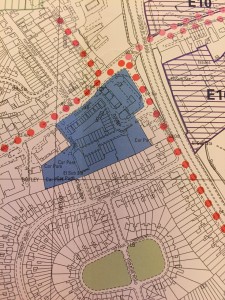I’ve set aside a few minutes this morning to give my view of the main events on Day 1 of the inspectors hearings. Corrections to any of my ‘facts’ are welcome. There may be things I havent realised; please let me know.
The first matter discussed (of four matters over these two weeks) was whether the Vale has satisfied its legal Duty to Cooperate with neighbourng authorities, particularly over the matter of how Vale will help to meet Oxford’s unmet housing needs.
The room was packed. There were probably more than 50 in the audience. There were about 25 or so at the table (authorised to speak) and five were women (incl me, obv, and Cllr Judy Roberts, who was at the table for Cumnor Parish Council. Helen Marshal Director of CPRE. Also a woman from SODC whom I don’t know, and Sophie Horsley, head of planning policy. Some female members of her staff also joined in sometimes). I tend to notice these days where any panel or committee is particularly unbalanced. You may have heard my song #blokesblokesblokes. Limiting bodies to all men is bad practice.
Anyway. The Queen’s Counsels at the table dominated the conversations, as I would have expected. Clients need to feel they are getting their money’s worth. They were all men.
Cllr Matthew Barber spoke and then stepped back from the table to let the officers and the Vale QC do the talking. I was surprised to notice Cllr Michael Murray wasn’t there; he’s the Cabinet Member for Planning Policy, and this is his most important work. Odd that he wasn’t there. I noticed two Tory Vale councillors (there are many new ones and I don’t know them all). Attending for the Lib Dems: Jenny Hannaby, Judy Roberts, Bob Johnston, Catherine Webber and me, of the current council. Dr Tony De Vere, and Richard Webber, previous leaders. Tories: 3 of their 29 councillors, Lib Dems: 5 of our 9 (Lib Dem Conference is going on right now).
Vale believe they have shown up in good faith at and participated in the Oxfordshire Growth Board meetings, which demonstrates compliance. OGB is apparently the vehicle where these numbers and locations were meant to be achieved. Vale thinks Oxford’s refusal to review its pre-SHMA Local Plan to see what more they could do to help themselves meet their increased needs has made resolution s-l-o-w. Vale decided they could NOT have Oxford’s reluctance to cooperate endanger their own Local Plan being adopted, so they put in the plan that they intended to cooperate fully, once the actual figures and the agreed number of houses Vale should take, were known.
Oxford City believe they have suffered, and will continue to do so, from Vale not doing enough in this Plan to meet Oxford’s unmet housing needs. The shortfall in City is believed to be from approximately 8000-16000, but no agreed process has completed to determine the real amount, nor to analyse potential locations and apply selection criteria to them. City thinks Vale should have done an estimate and included that number of extra houses in their plan. Even as few as 50, would have satisfied them that Vale are doing all they can, QC said. (An odd argument, I thought.)
At this point I stated that Vale had an evidenced based plan (how many times have we heard that?) and to take a guess in this instance and use any old number would have been met with outrage from the public, and a plan based on such a random guess would likely not be found sound either. One of the QCs and the County Council (who want this plan adopted yesterday so they can get on with infrastructure plans) took that argument forward (that was fun!).
Last point: Green Belt boundaries are not to be changed very often. The plan removes 18 sites from Green Belt protection. If Oxford’s unmet need must be satisfied by developments in the Green Belt, is there enough land now being removed to accommodate this undetermined number? Vale first said hat couldn’t be known because there has been no process to identify locations or sites for Oxford. Oxford argued that it was obvious that GB boundaries would need to change again. Then Vale changed their message and said there was enough space identified in the current spatial strategy, plus their building is actually producing more windfalls now, that Vale were confident they’d be able to meet their share of Oxford’s unmet need without further GB boundary review.
At this point, there were gasps throughout the hall, as Vale changed their position. Inspector then asked his two authorities to go away and come back in a week to report if they had any common ground to agree between them. I thought the scene very odd; it looked like Vale hadn’t thought their position through. So we have that outcome to hear about by next Tuesday.
I don’t support this Local Plan 2031, but not on the grounds of Duty to Cooperate not being met. The duty to cooperate isn’t a duty to agree. I think Vale did the best they could, relying on a weak process that isn’t effective , within the Oxfordshire Growth Board. (Which is all men.)


